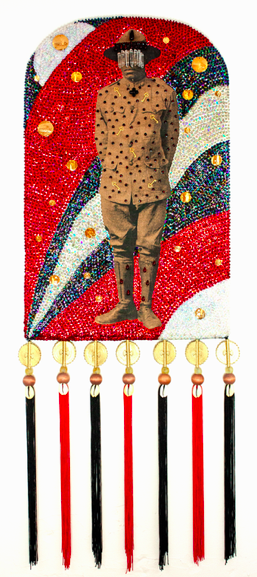Stories Untold
Black Gold
Fort Point
Golden Gate National Recreational Area
Ongoing – November 2
Something extraordinary is happening right under the Golden Gate Bridge. A mix of 17 new and established contemporary Black artists from the US and Britain have filled Fort Point with art. Black Gold tells forgotten stories focused on the experience of African-Americans in California from the period of the Gold Rush through Reconstruction (1849-1877). These works wrap around, making relevant statements that echo the past, yet speak loudly to the present.
This installation of composed of all recent artworks, including nearly a dozen commissioned pieces, to highlight important but lesser-known figures and narratives from California’s history. The artworks explore the presence of slavery and the struggle for legal rights within this “free” state, the successes of Black entrepreneurs, and the experiences of African American Army regiments known as the Buffalo Soldiers. More broadly, the exhibition illuminates the role that Black communities played in the cultural, social, and political environs of that time.
Why Stage the Exposition at a National Park?
According to Chris Lehnertz, CEO of the Golden Gate National Parks Conservancy, “National Parks are a place where everyone can feel welcome and … this exhibition is a powerful way to ensure more people see their history, contributions, and perseverance reflected in these iconic spaces.”
L to R: Thomas, Solidarity and in situ; Brionne, Mary Ellen Pleasant
An abandoned fort may seem like an unlikely place until you consider that much of the history presented here has also been abandoned. Without such displays that history would molder, much like the walls of Fort Point.
Examples of the “Stories Untold”
Mary Ellen Pleasant
Often a footnote because the park dedicated to her is the smallest park in California (located at the corner of Bush and Octavia Streets.
The wealthiest African-American woman during the Gold Rush.
Known today as the “Mother of Civil Rights in California,” she funded John Brown’s raid on Harpers Ferry, assisted the slave Archy Lee in his historic court case to be declared a free man, and helped desegregate street cars in San Francisco. Her victory against the Omnibus Railway Company made her the first person to win equal rights for African Americans to ride public transportation, almost 100 years before Rosa Parks.
Brigadier General Charles Young
One of the highest ranking African-American soldiers in the country and leader of the Buffalo Soldiers.
A composer and skilled pianist, Young was also a well-traveled Black man who spoke multiple languages, despite being born enslaved.
A lifelong friend of former colleague W.E.B. Du Bois, and mentor to Sgt. Maj. Benjamin O. Davis, Sr., the first Black general in the U.S. Army.
When Theodore Roosevelt marched down Market Street, he requested that Charles Young and the Buffalo Soldiers escort him.
Cowrie Shells
Broxton incorporates cowrie shells into this work, drawing on their historical use both as currency in Africa and as payment for bodies in the Transatlantic Slave Trade.
The shells also symbolize protection, wealth, and fertility in West African cultures.
There are a baker’s dozen more stories to discover at Fort Point.
L to R: Broxton, Eyes That Have Seen the Ocean Will Not Tremble at the Sight of the Lagoon; Shonibare, Man Moving Up; Massey, 72 Reasons Why I’m Not Playing
Don’t Be Shy
One of the most compelling elements of the overall project is its prominent educational element. Each artist creatively interprets the life and experiences of particular figures, only after reviewing the extensive research provided to them.
If you are the kind of person who likes to read up on such things first, Black Gold was inspired by Golden Chains: The Hidden History of Slavery in California, a public education campaign produced by the ACLU of Northern California. (Click here for website.)
Alternatively, check out the podcast!
On second thought, just go! In the current climate, an exhibition on federal land dedicated to African-American history could find itself forced to close unexpectedly.
At Fort Point, you will find informational signage and educational material to best understand and interpret the historical context of these individuals. There is also a volunteer docent program, knowledgeable on the historical contexts of the works.
For more information on Black Gold, click here.
My thanks to Jaelynn Dale Walls, SF/Arts and Pendarvis Harshaw, KQED










